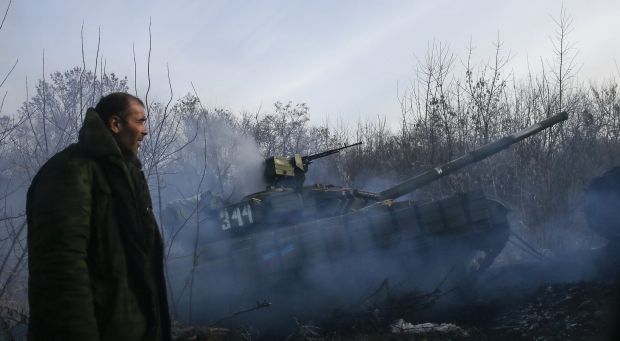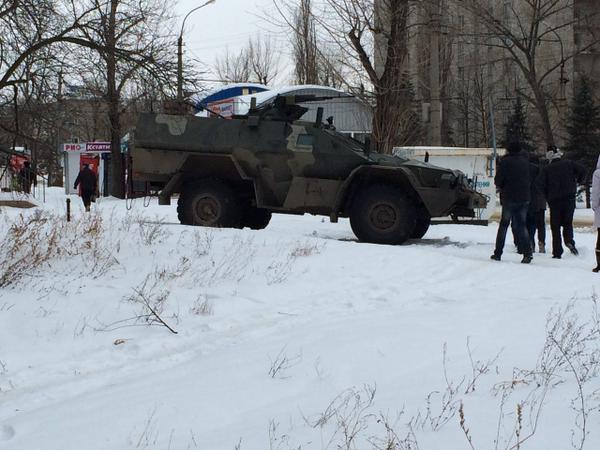
Ukrainian Prime Minister Arseniy Yatseniuk has said that Ukraine has 50,000 men participating in what the government calls its “Anti-Terrorist Operation” (in reality a counter insurgency/anti-invasion operation), but by no means all of them can be deployed in the area of operations at once. Estimates of the strength of the Russian-backed and Russian-supported forces vary, but the number could be as high as 20,000 - some 7,500 of whom are Russian regular troops, according to Ukrainian Defense Minister Stepan Poltorak.
If the numbers of the militants are increasing, and assuming the numbers of Ukrainian soldiers manning the frontline has remained constant, then the increase in the militant’s manpower could only have come from one source – Russia.
There is evidence that this is the case. The Associated Press recently filmed a group of Chechen fighters manning a checkpoint in the Donbas, and it has long been known that Chechens have been present among the militants. The number of Russian regular troops is harder to establish: The BBC, in a recent report, filmed Russian mercenaries in the militant seized territories, and said that Russian troops were also present, but gave no evidence.

Nevertheless, there are indirect signs that Russian regular troops have been sent to reinforce the militants as well. New types of vehicles have been spotted in the conflict zone, such as the BMP-97 armored car, which is only used by the Russian armed forces and could only have been sent by Russia. Sophisticated electronic warfare equipment has been sighted, as well as air defense complexes, which are almost certainly operated by highly trained Russian servicemen. Ukrainian troops have noted the difference in the precision of artillery strikes when they are directed by regular Russian troops as opposed to known militant groups. Russian regular troops have been captured on Ukrainian soil, and others have been interviewed by Western journalists in a café in Luhansk. Moreover, it recently emerged that Russia has set up a massive base (four times the size of London Heathrow Airport) in Rostov region, which is placed so that it is equidistant from the main areas of confrontation – Donetsk, Luhansk and Mariupol. This allows Russia not only to rotate troops in and out of the conflict zone easily (and why would it need to do that if the troops were not there?), but also means that it could respond within hours to any advances by Ukrainian forces.
Add to all this the various sightings from within the zone itself of Russian regular forces reported by journalists local and international, it cannot now be seriously claimed that Russian regular troops do not make up a significant part of the militants’ manpower.
There is no evidence of a large rise in the number of local recruits for the militant forces – quite the opposite: Russian militant leaders, notably Igor “Strelkov” Girkin, have long complained of the local population's lack of enthusiasm for the Kremlin’s Novorossiya project, and reports from within the militant-seized parts of Ukraine point to Russian attempts to unify all the informal armed groups under a single command structure. This has resulted in conflicts between rebel groups, notably the “Don Cossacks” and militias of the Luhansk People’s Republic organization, and the execution of several militant leaders. A video appeared recently on the Internet of an aggrieved minion of the murdered militant leader Alexander “Batman” Bednov, who groaned and puffed mawkishly about taking revenge on the leader of the LPR, Igor Plotnytskiy. Morale among the militants is low due to these killings and the obvious failure of the Novorossiya project so far.
So if, as it seems, the number of Russian regular troops in the conflict zone has indeed increased, what does this mean for the future of the conflict?
Some commentators have assumed that Russian President Putin, having evidently bitten off more than he could chew in the Donbas, has decided to settle for keeping the area as an open sore, a frozen conflict, with which to pressure and destabilize the government in Kyiv whenever he deems it required. That is a reasonable assumption: The logic of the Kremlin’s moves, first taking Crimea, then destabilizing the east of Ukraine, pointed to an overall aim of establishing a land bridge though the south and east of Ukraine to Crimea. That, given the strength of Ukrainian resistance, now looks to have been a hopelessly optimistic goal, and the Kremlin has probably abandoned it.
But that is assuming Vladimir Putin is still a reasonable man: his dictatorship in Russia may have reached the stage when his sources of information (he is said not to use the Internet) have been restricted to a few trusted underlings. However, the recent crackdown in Moscow by an overwhelming number of riot police on a relatively small opposition demonstration may indicate he is still not confident he is completely in control. And he no longer refers to “Novorossiya” in his speeches, which may mean he understands that cause is lost.
All the same, we must still account for the apparent increase in Russian regular forces in the Donbas. What purpose might that serve, if Moscow is indeed content to settle for a frozen conflict?
The new supplies of vehicles, which Russia is no longer even seriously attempting to hide, along with the air defense and electronic warfare equipment, allows Moscow to keep its options open. The reinforcements effectively rule out any attempt by Ukraine, which has nevertheless been reinforcing its own army, to take the initiative militarily. The air defense system neutralizes Ukrainian airpower, which Kyiv would need to wield to deal with the militants’ tank force, and also provides cover for a militant tank advance. The destruction of key bridges in the area, which was carried out before the Christmas holidays, can be seen not only as a defensive tactic but a way to guard vulnerable flanks when pushing ahead with an advance. And the large Russian hub base in Rostov region, which may have been around since August or even earlier, allows the Russians not only to respond quickly to a Ukrainian advance, but to launch an advance of their own.
Meanwhile, Russia seems in no hurry to go back to the negotiating table. The “Normandy format” meeting proposed to take place in Astana on January 15 now looks unlikely to go ahead. It is to Ukraine’s advantage that such a format of talks, involving not just itself and Russia, but Germany and France as well, goes ahead, as Ukraine has little chance of wrong-footing Russia diplomatically without the support of these powerful Western countries. Russia, which has flouted the Minsk peace accords since day one, may not see any benefit in getting involved in talks that end up with it making more commitments that it has no intention of meeting. Stalling, and continuing “talks about talks” seems to be the plan for now.
It could be, then, that Russia is weighing two options: continued military stalemate, or a further aggressive thrust to take more territory. It certainly seems to be keeping both options open, judging by the moves it has been making on the ground. Although there was a decrease in fighting following Ukraine’s unilateral declaration of a “silence regime” on December 9 – in reality nothing but a failed ceasefire within a failed ceasefire - there has been a marked increase in fighting in the last day or so, up to levels not seen for months. And Russia needs to take more Ukrainian territory to make its Donbas statelet more viable, even if it ends up in a loose confederation with the rest of the country, within the present borders of Ukraine.
To do that, Russia will need more troops on the ground. The signs do not look good. Ukraine would do well to loudly and visibly increase its defenses.


